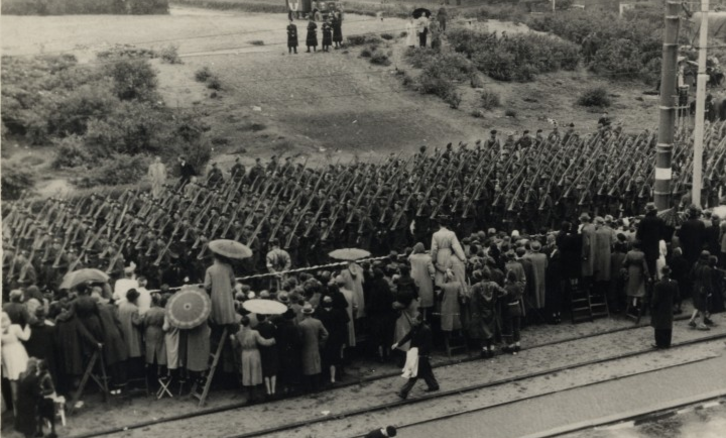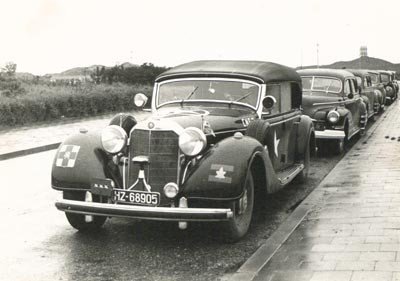The weather
Until the 21st, the month of May 1945 had been very sunny, but on this Whit Monday the weather gods had other plans. Rain fell steadily all day, and the temperature was just above 13 degrees. That was of course annoying for the many spectators along the route, many of whom peered from beneath their umbrellas. But the miserable weather also prevented the contribution of the Royal Air Force, which was supposed to fly over with no fewer than 84 formations.
Not the queen, but the prince
Newspaper announcements of the upcoming Victory Parade stated that HM Queen Wilhelmina would attend the event. This would have been the first time that she would be seen in her residence again, after residing in London for the duration of the war.
However, Wilhelmina had to devote her time to the formation of a new government. That day she had a meeting with representatives of political parties, including Mr Kolfschoten, who later became mayor of The Hague. The Queen sent her son-in-law Prince Bernhard in her place.
The Victory Parade
This was followed by a detachment of Marines and Sailors, and then seven battalions that contained officers and men of all regiments of the First Canadian Army. In total, 8,000 Canadians participated.
The parade was concluded by 1000 members of the Interior Forces, who marched for the first time for their Commander-in-Chief, Prince Bernhard. The Interior Forces had recently been formed by bringing together several existing resistance groups.
Savornin Lohmanplein
A platform had been set up on Savornin Lohmanplein from where the high-ranking military would view the parade. The square had suffered greatly during the war, but it was decorated with beautiful flowers and plants for the occasion.
Twelve heavy guns from the 56th Heavy Regiment of the Royal Artillery were placed around the square. Fifteen minutes after the procession had left Valkenbosplein, these guns fired a 21-gun salute. Prince Bernhard climbed the platform shortly afterwards together with General Crerar, commander of the First Canadian Army. In addition to other senior officers, Mayor De Monchy and his wife were also present.
It took about 20 minutes for the parade to pass the platform, marching to the cheerful music of a large military band. After the dignitaries had lunched, another parade of the “Mass Piped Bands” followed on a field behind the platform.
Prince Bernhard’s car
Prince Bernhard came to the parade in a very special car. His staff car was the Mercedes-Benz 770, which had been the official car of Reichskommissar Seyss-Inquart with the registration number RK1 (for ReichsKommissar). This car had been found in Delden (Overijssel) after Seyss-Inquart had abandoned his post, and was later donated to Prince Bernard.
Of course I wanted to know what happened to this car after the war and on the internet I found this text from 2014 on a forum:
“The RK1 was hidden in the Royal stables in The Hague for two years. My uncle worked there at the time and Wilhelmina regularly held inspections. One day in 1947 she saw a car under a cover and became very angry. To Bernhard’s dismay she ordered the car’s destruction. My father and my uncle took off the parts that they could easily get off, floodlights, sunshades etc. and the car was cut to pieces with torches. I was 7 years old at the time and sat in the car once. It was huge, the hood had to be opened by two people!”
Parade’s end
At half past two the Prince and his company drove slowly along the Laan van Meerdervoort in the direction of the centre. Despite the still-falling rain, many people remained along the route, cheering him warmly.
Remembrance
75 Years after the victory parade on 21 May 2020, a remembrance table was unveiled. Thus, on the De Savornin Lohmanplein we are permanently reminded of the efforts and sacrifices of our liberators. And to the joy that the residents of The Hague must have felt at their liberation.
There is footage of the victory parade, which you can find on: Haagse Filmbank.
Do you want to know more about The Hague during the Second World War? Book my bicycle tour ‘The Hague in World War II










